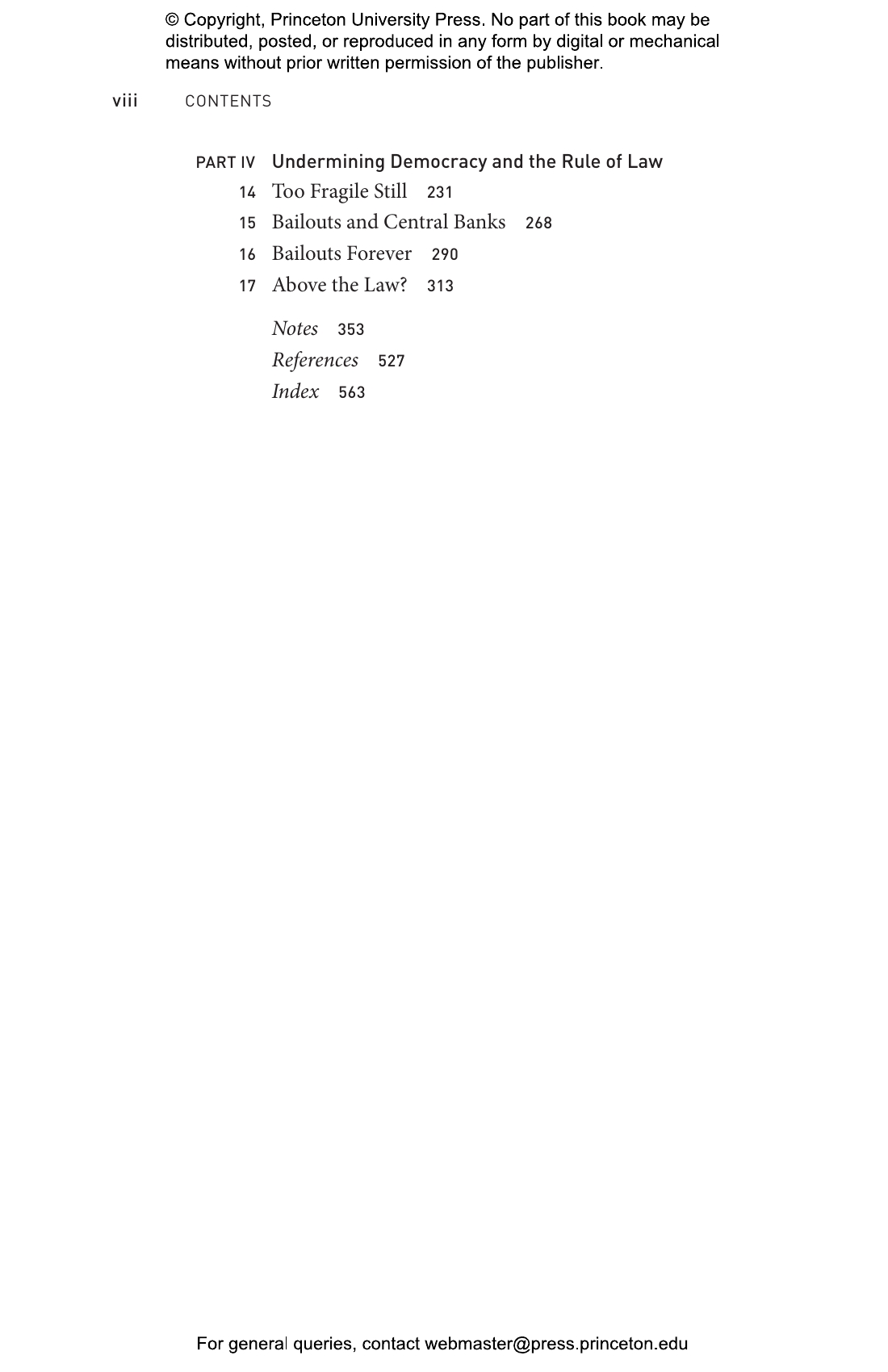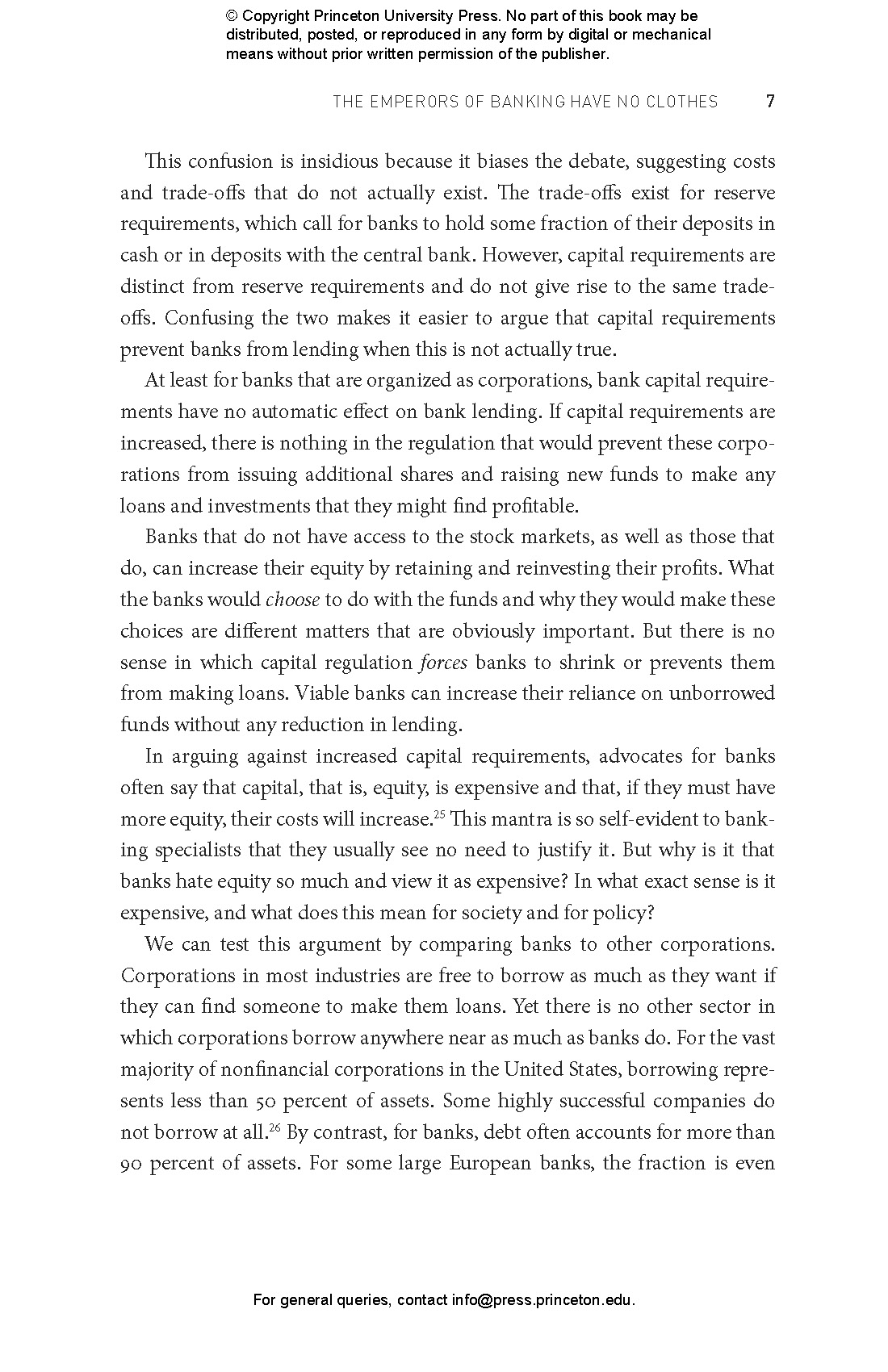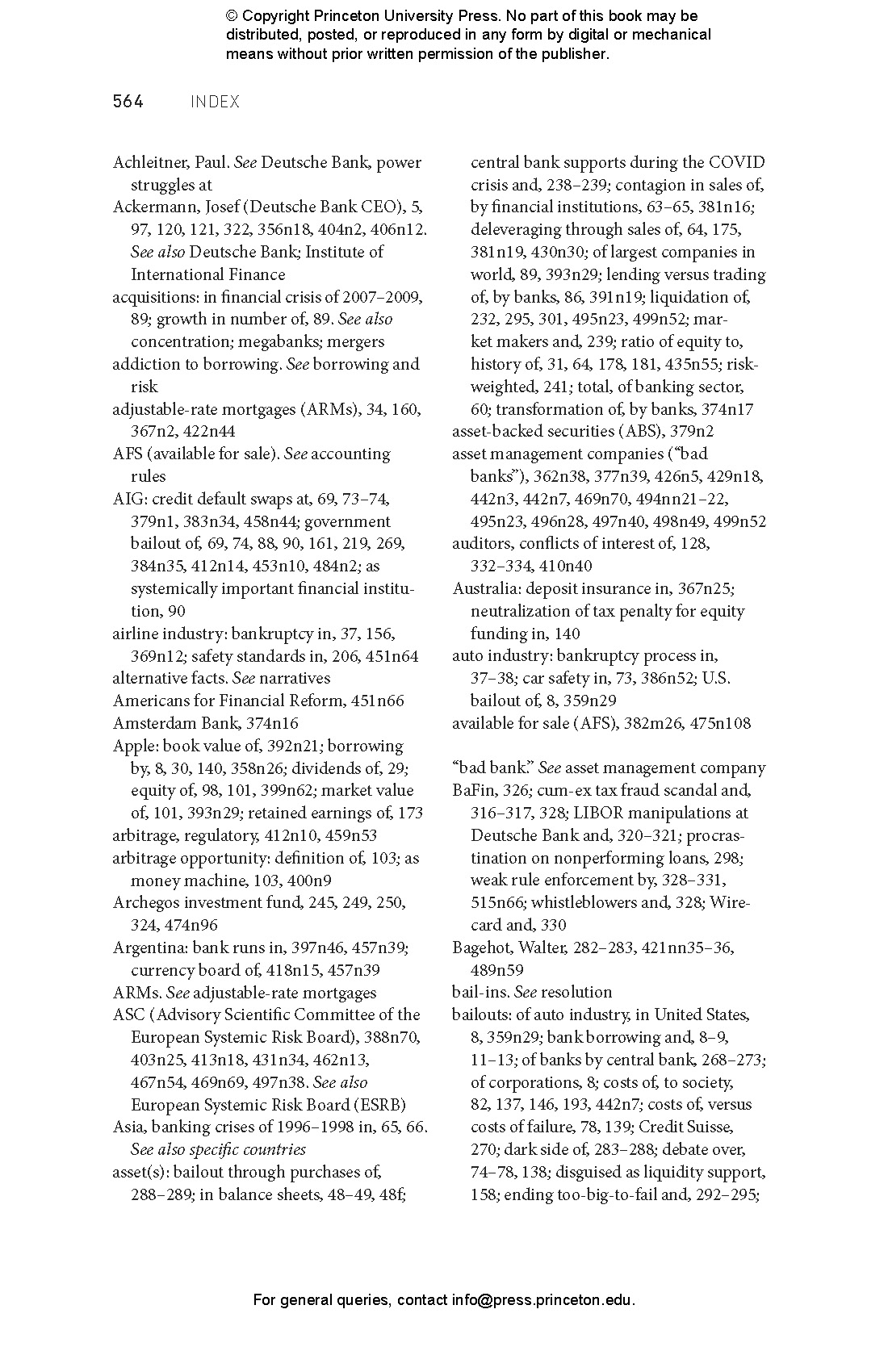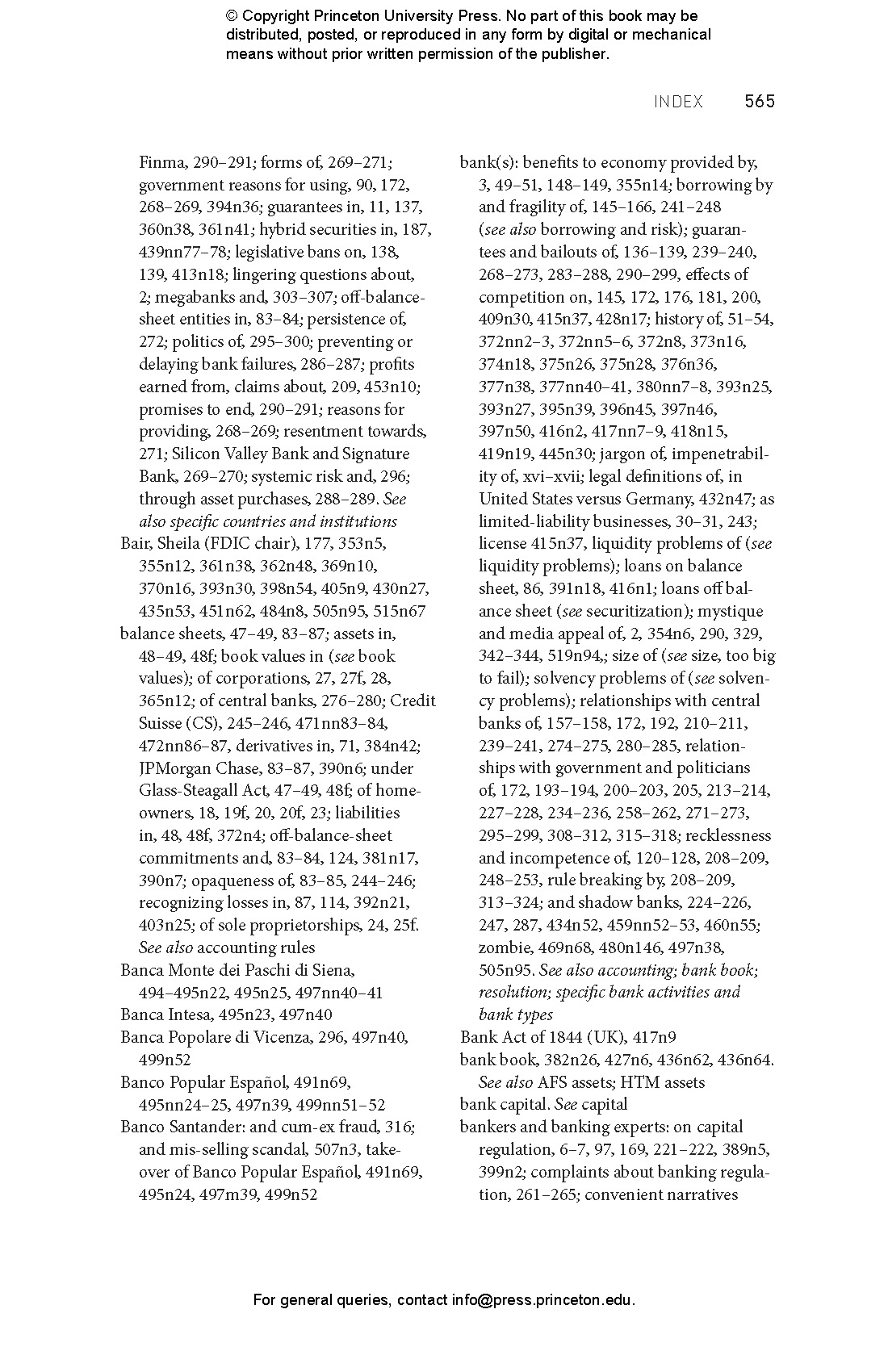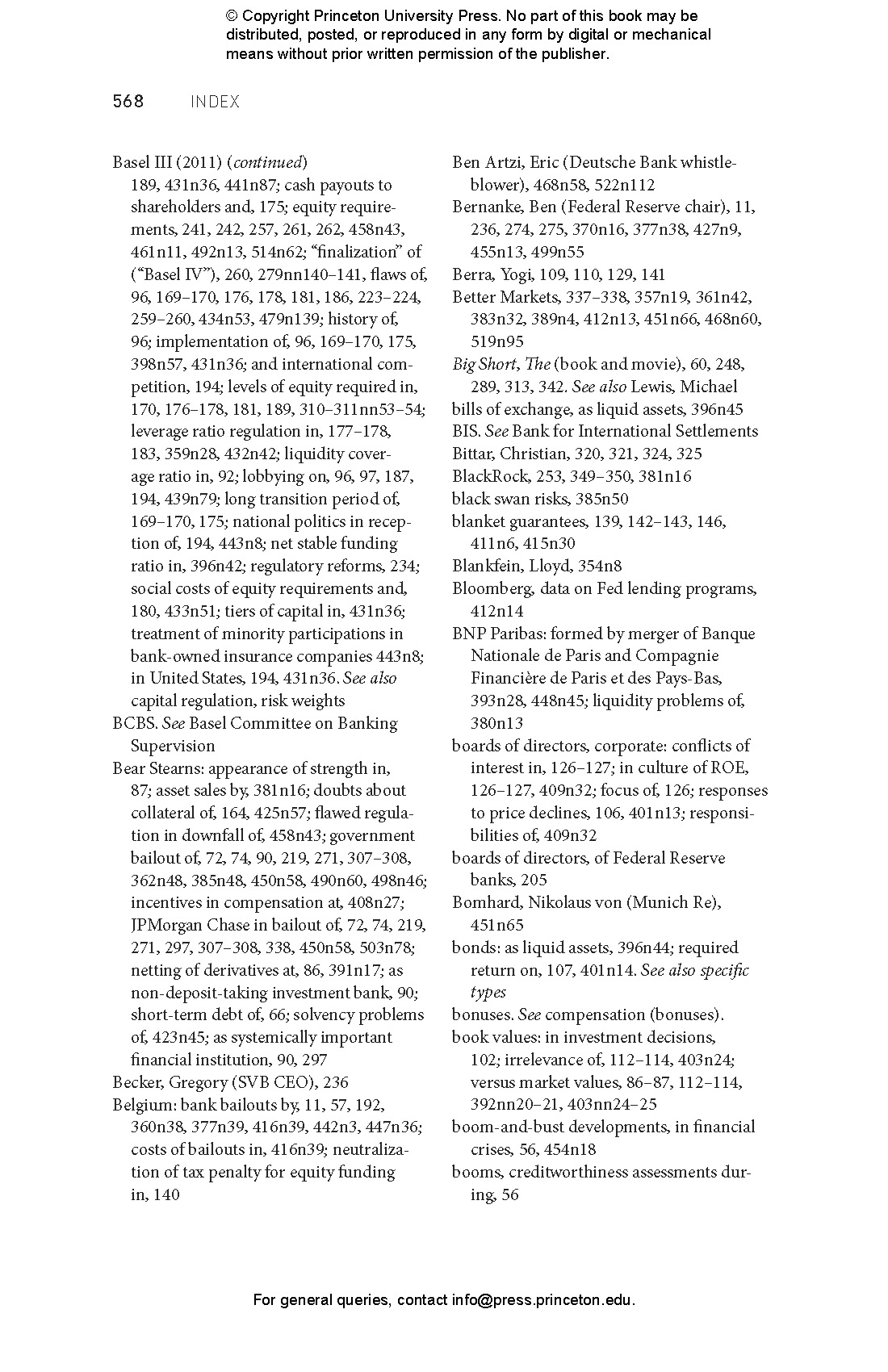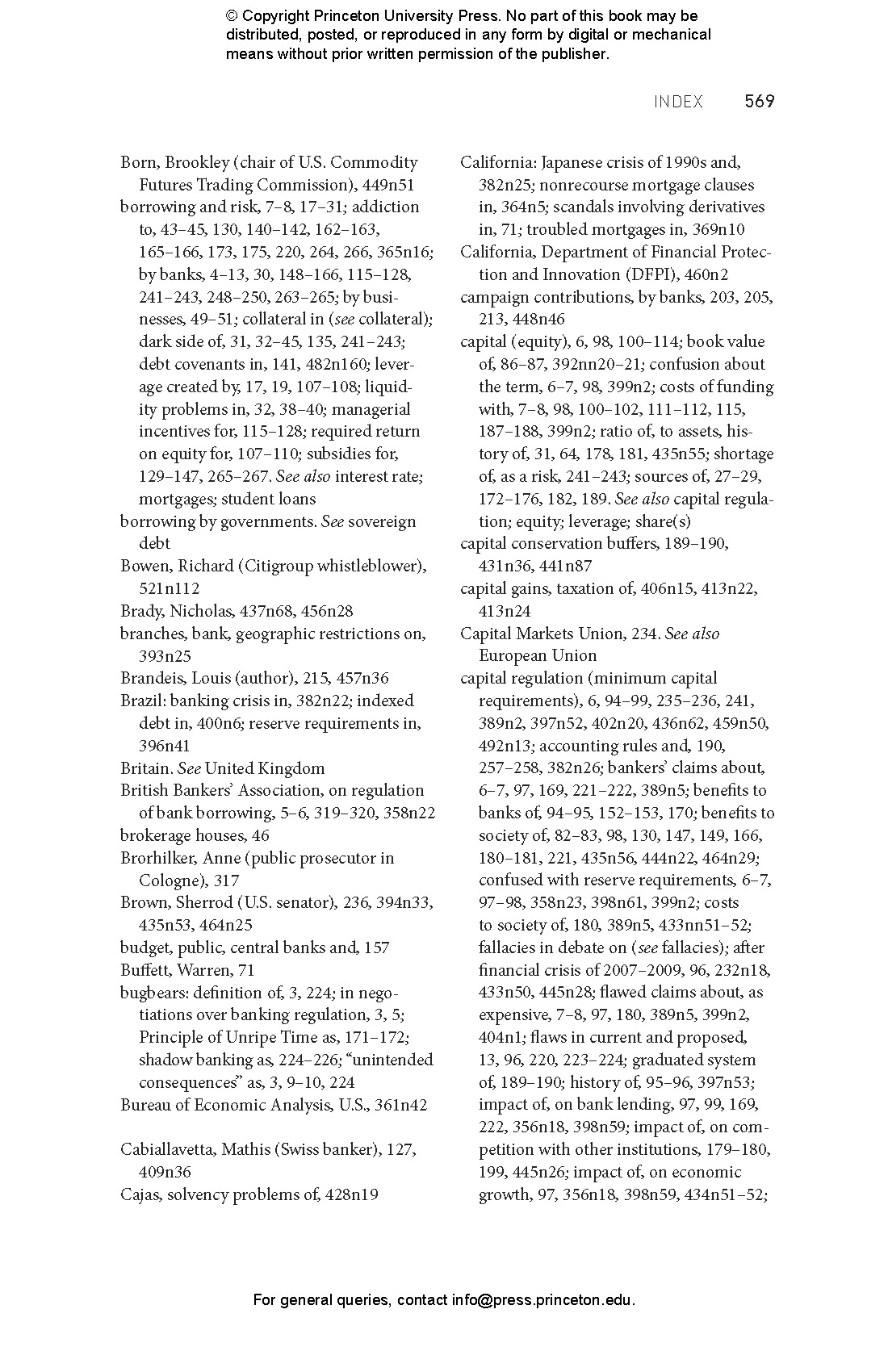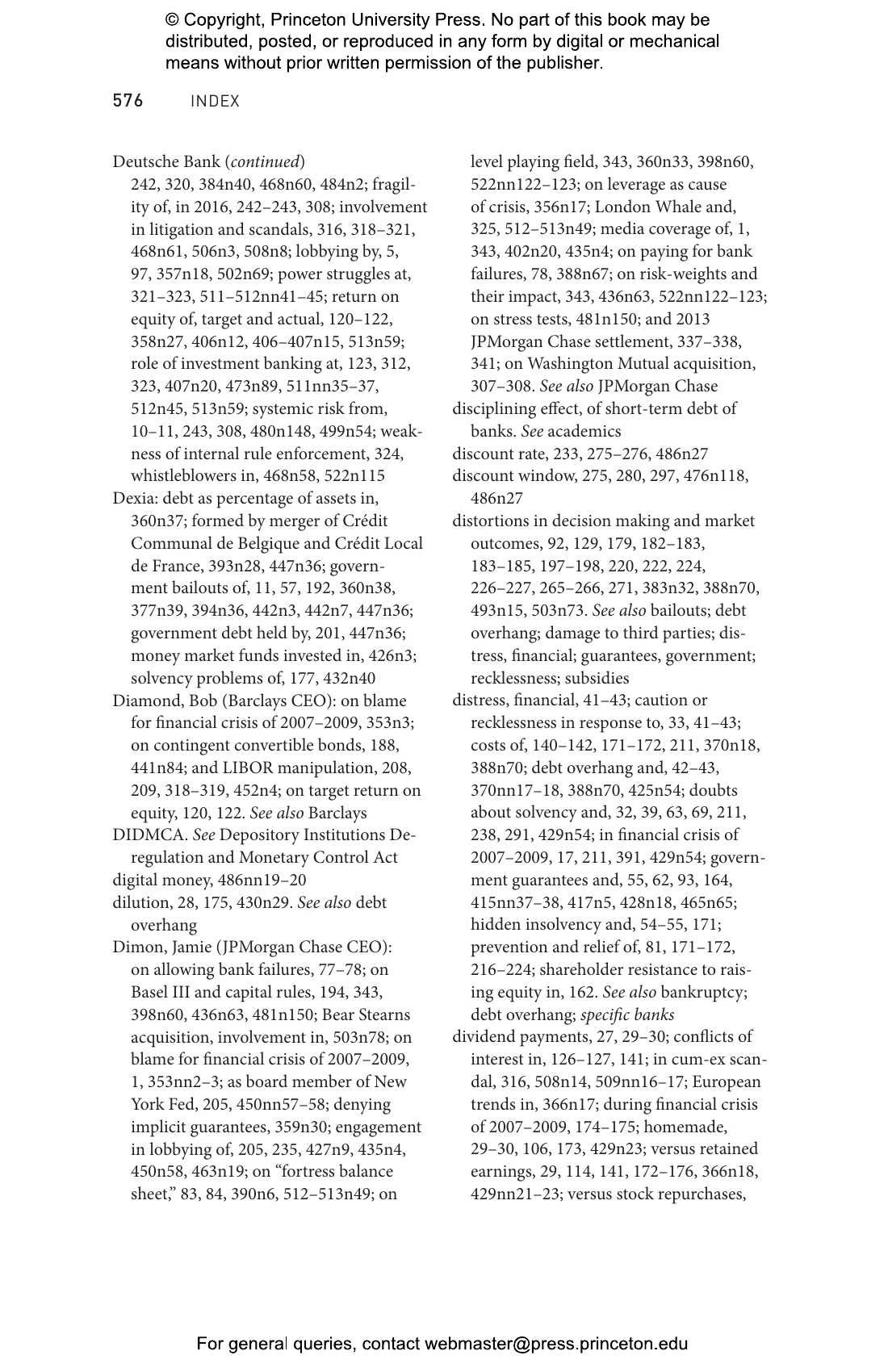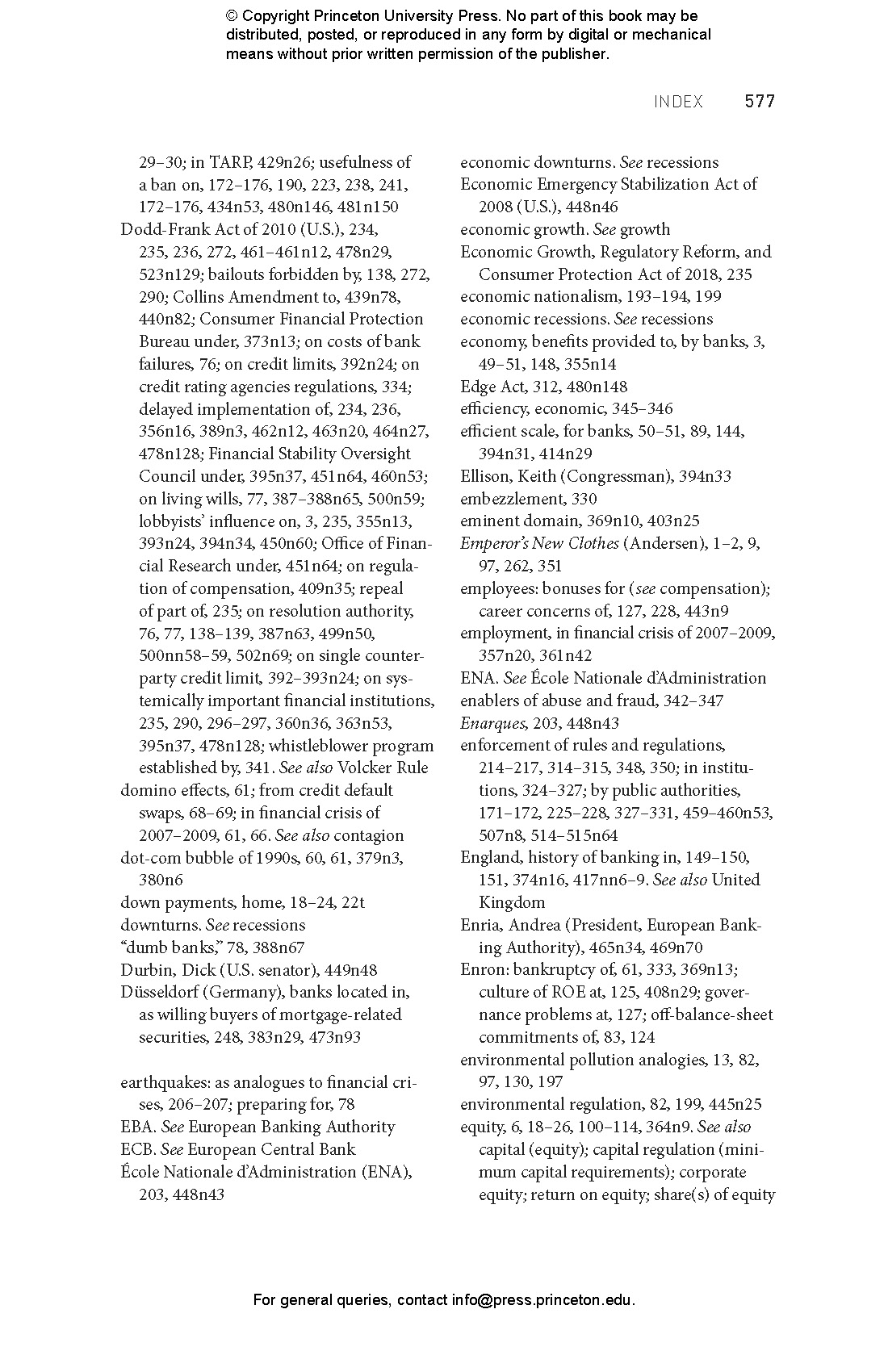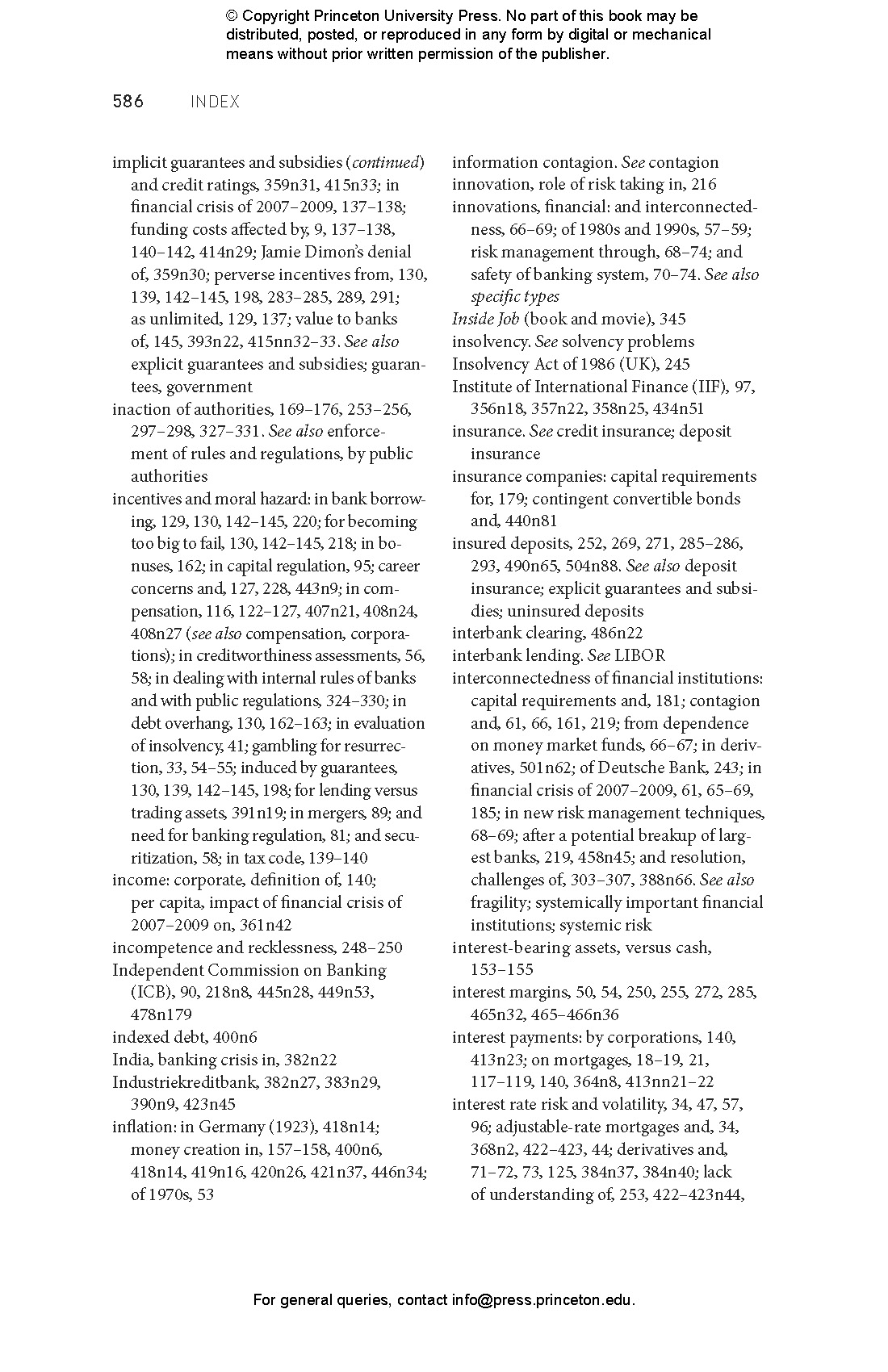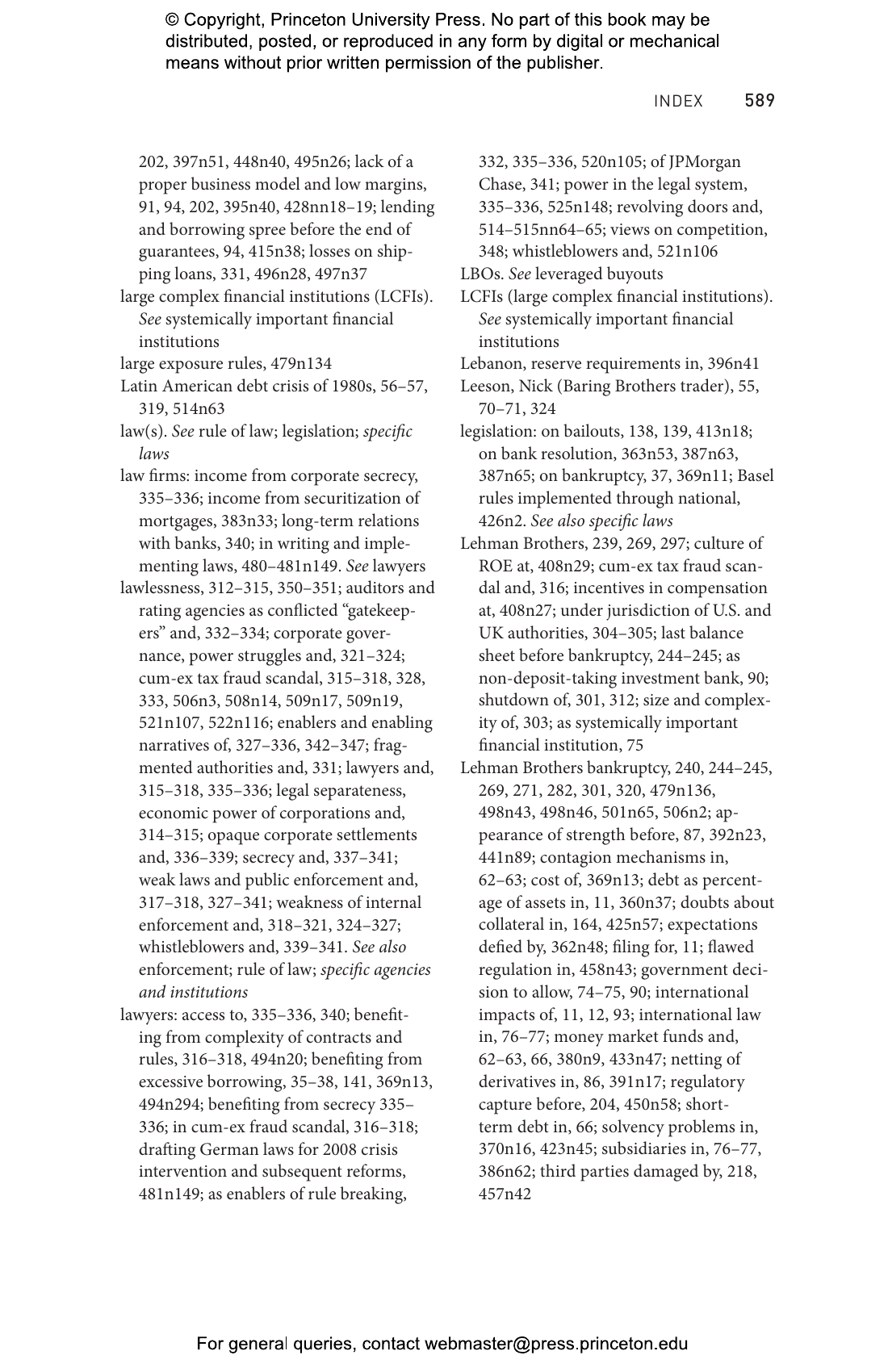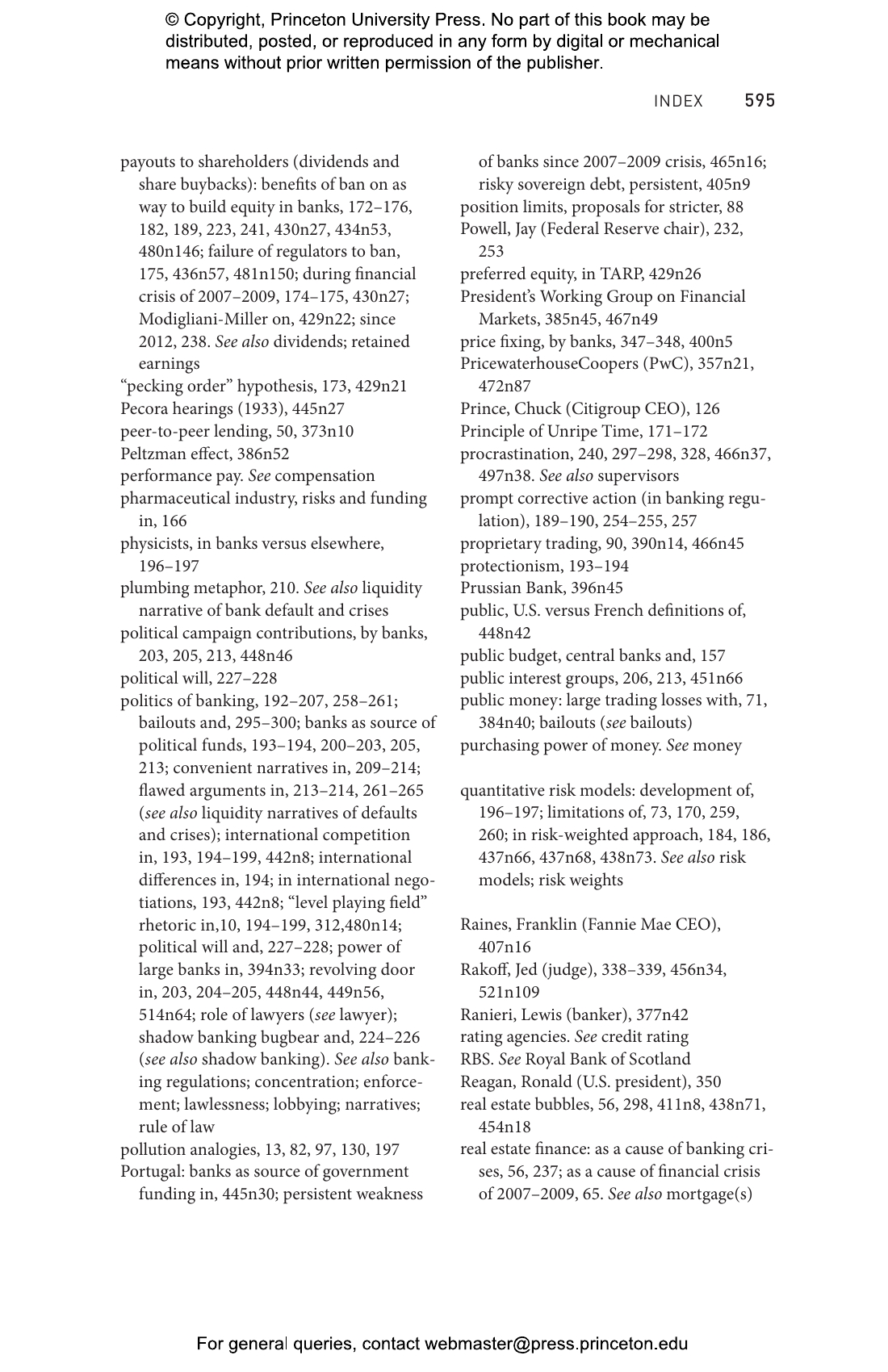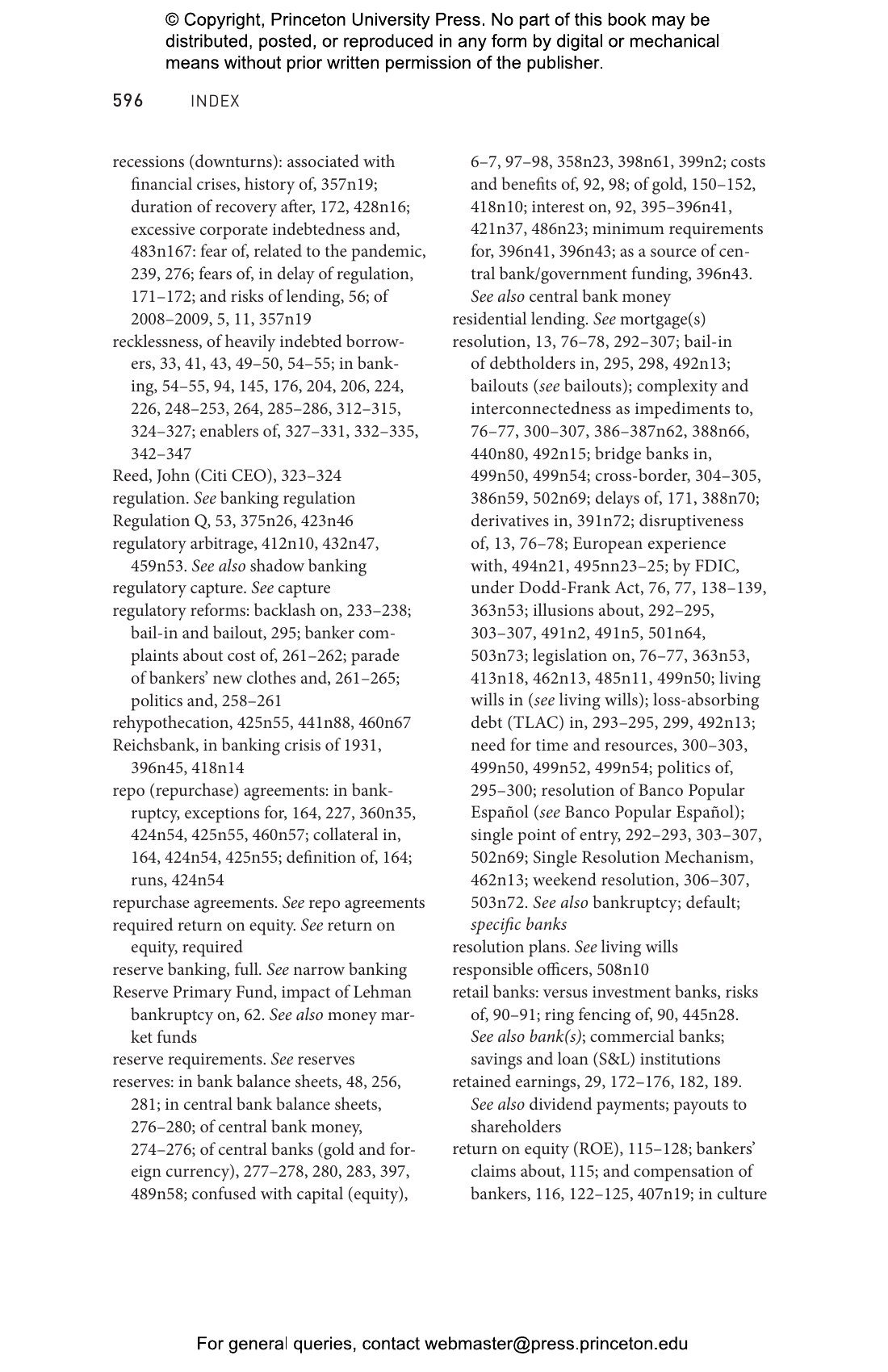The Bankers’ New Clothes: What’s Wrong with Banking and What to Do about It - New and Expanded Edition
A Wall Street Journal, Financial Times, and Bloomberg Businessweek Book of the Year
Why our banking system is broken—and what we must do to fix it


Paperback
- Price:
- $19.95/ÂŁ16.99
- ISBN:
- Published (US):
- Jan 9, 2024
- Published (UK):
- Mar 5, 2024
- Pages:
- 624
- Size:
- 5.5 x 8.5 in.
- Illus:
- 6 b/w illus. 4 tables.
- Main_subject:
- Economics & Finance
ebook
- Price:
- $19.95/ÂŁ16.99
- ISBN:
- Published (US):
- Jan 9, 2024
- Published (UK):
- Mar 5, 2024
- Pages:
- 624
- Size:
- 5.5 x 8.5 in.
- Illus:
- 6 b/w illus. 4 tables.
- Main_subject:
- Economics & Finance
New bank failures have been a rude awakening for everyone who believed that the banking industry was reformed after the Global Financial Crisis—and that we’d never again have to choose between massive bailouts and financial havoc. The Bankers’ New Clothes uncovers just how little things have changed—and why banks are still so dangerous. Writing in clear language that anyone can understand, Anat Admati and Martin Hellwig debunk the false and misleading claims of bankers, regulators, politicians, academics, and others who oppose effective reform, and they explain how the banking system can be made safer and healthier. Thoroughly updated for a world where bank failures have made a dramatic return, this acclaimed and important book now features a new preface and four new chapters that expose the shortcomings of current policies and reveal how the dominance of banking even presents dangers to the rule of law and democracy itself.
- Preface to the 2024 Edition
- Preface
- Acknowledgments
- 1 The Emperors of Banking Have No Clothes
- PART I Borrowing, Banking, and Risk
- 2 How Borrowing Magnifies Risk
- 3 The Dark Side of Borrowing
- 4 Is It Really “A Wonderful Life”?
- 5 Banking Dominos
- PART II The Case for More Bank Equity
- 6 What Can Be Done?
- 7 Is Equity Expensive?
- 8 Paid to Gamble
- 9 Sweet Subsidies
- 10 Must Banks Borrow So Much?
- PART III Moving Forward
- 11 If Not Now, When?
- 12 The Politics of Banking
- 13 Other People’s Money
- PART IV Undermining Democracy and the Rule of Law
- 14 Too Fragile Still
- 15 Bailouts and Central Banks
- 16 Bailouts Forever
- 17 Above the Law?
- Notes
- References
- Index
"Indispensable."—Jesse Eisinger, New York Times
"Crucial."—James Surowiecki, The New Yorker
"This is the second edition of the most original and important book to have emerged from the financial crisis of 2007-08."—Martin Wolf, Financial Times
"The most important [book] to emerge from the crisis. . . . The authors achieve three things. First, they explain basic financial theory with simple examples that any moderately numerate individual can understand. Second, they show that these basic ideas apply, with modest differences, also to banking. Finally, they prove that, in opposing them, bankers and their apologists have spun intellectual raiment as invisible as the emperor's new clothes. . . . Read this book. You will then understand the economics. Once you have done so, you will also appreciate that we have failed to remove the causes of the crisis. Further such crises will come."—Martin Wolf, Financial Times
"Powerful. . . . The authors persuasively argue that the solution is higher levels of equity capital throughout the banking industry to offset the impact of the implied government protections against failure."—The Economist
"Excellent."—Matthew Yglesias, Slate
"Ms. Admati and Mr. Hellwig, top-notch academic financial economists, do understand the complexities of banking, and they helpfully slice through the bankers' self-serving nonsense. Demolishing these fallacies is the central point of The Bankers' New Clothes."—John Cochrane, Wall Street Journal
"An important new book called The Bankers' New Clothes . . . offers what the Dodd-Frank legislation mostly lacked: a simple and elegant solution to the problem of financial stability. [Admati and Hellwig] argue that banks should fund themselves with more equity and less debt—or, to put it bluntly, that banks should risk more of their own money, and less of everyone else's."—Christopher Matthews, Time
"Insightful."—Floyd Norris, New York Times
"Important."—John Cassidy, The New Yorker
"Anat Admati and Martin Hellwig convincingly make the case for much stronger and simpler borrowing limitations for banks."—Roger Alcaly, New York Review of Books
"In a year of important books about the recent economic crisis, the most important one told us simply how to stop the next one."—Wall Street Journal
"The book pounds quite the drumbeat here: Force banks to borrow less (they should make up the difference through issuing more equity stock) and so inject sanity into the system."—Katharine Whittemore, Boston Globe
"Admati and Hellwig have done something extraordinary. They took [banking] frustration and all its complex details and gave it a simple narrative, one that both explains what banks have been getting away with and what we might ask that Congress do about it."—Brendan Greeley, Bloomberg Businessweek
"Anat Admati and Martin Hellwig are academics with a gift for taking the mind-numbing minutiae of banking and presenting it in a way that the average reader can understand. One by one, the self-serving protests of the banking industry against tougher regulations are lined up and struck down in The Bankers' New Clothes. . . . The authors map out the regulatory flaws that make it easy for debt-junkie bankers to get rich when times are good, and leave them hanging around protesting when times are worse thanks to their own recklessness."—Susan Antilla, Bloomberg News
"Admati and Hellwig explain, in layman's terms, some of the silly arguments bankers make for keeping to the status quo and preventing any new regulation of the banks from ever being enacted. And they do a great job. . . . Admati and Hellwig have made a gift to you. You don't have to go wrestle with banks' financial statements or their annual reports or their 10Q's. You don't need to pull out your old accounting textbooks or call your college economics teacher to have her explain to you again why debt leverage increases risk. Admati and Hellwig have done all the hard work for you. But, you have to read their book."—John R. Talbott, Huffington Post
"Anat 'gets' banking, and gets it better than most. The fact that she is ruffling feather relates more to the fact that she is questioning deeply held—yet hardly ever challenged—belief systems within the industry, than any lack of understanding."—Izabella Kaminska, FinancialTimes.com's Alphaville blog
"This book's aim, decisively achieved, is to de-mystify the public conversation about banking so we can all understand how threadbare the industry is."—Diane Coyle, Enlightened Economist
"Admati and Hellwig offer a simple prescription for this complex world."—Thomas G. Donlan, Barron's
"The Bankers' New Clothes makes a powerful case for why banks should stop borrowing so much."—Rana Foroohar, Time
"Buy this book; read this book; give this book to your friends; discuss this book; act on this book."—Carol Hunt, Irish Sunday Independent
"This is the most important book to have come out of the financial crisis. It argues, convincingly, that the problem with banks is that they operate with an order of magnitude too little equity capital, relative to their assets. Targeting return on equity, without consideration of risk, allows bankers to pay themselves egregiously, while making their institutions and the economy hugely unstable."—Financial Times
"The Bankers' New Clothes is wowing critics of fragile banks with a simple and attractive message: Force banks to have much thicker cushions of capital and you can make them safer without paying any cost in terms of higher interest rates, less lending, or lower economic growth."—Peter Coy, Bloomberg Businessweek
"Admati and Hellwig's analytical rigour is convincing. . . . The value of The Bankers' New Clothes is that it sets all out in clear and accessible terms over little more than 200 pages, without cutting corners."—George Hay, Reuters Breakingviews
"The Bankers' New Clothes is a lucid exposition of the intellectual falsehoods deployed by banks to justify the ways in which they went about growing their business beyond any reasonable assessment of risk in the run-up of the crisis of 2008 and which they continue to peddle today. Admati and Hellwig cut through the debates about whether it was too little or too much regulation that was to blame, whether central banks could and should have acted faster, and the rights and wrongs of securitisation or separating commercial and investment banking, and go to the heart of the matter."—Will Hutton, New Statesman
"[Admati and Hellwig] have done an admirable job in explaining how capital in the banking system works to absorb shocks, and how too little of it makes banks unstable."—The Economist
"The banks' argument that equity capital is expensive and that increasing equity capital would force them to pass up otherwise attractive lending opportunities has been systematically demolished, most notably by the academics Anat Admati and Martin Hellwig. In a new book they argue . . . that both the equity and debt of well capitalised banks are safer and thus cheaper, while a lower return is perfectly acceptable to investors in exchange for lower risk."—John Plender, Financial Times
"[The Bankers' New Clothes is] a clearly written, sensible analysis of problems and cures for the U.S. banking system. . . . Admati and Hellwig take a lot of time to clearly explain the problems with depending too much on borrowed money."—Dale Singer, St. Louis Post-Dispatch
"Thought provoking."—Heather Stewart, The Observer
"One of the greatest strengths of this book is that it clearly explains the issues for the ordinary reader. Financial reform shouldn't be left solely to Wall Street bankers and their captured policymakers in Washington, D.C., to decide. Regular citizens must make their voices heard, and this book will help them understand the basic terminology and concepts. I encourage everyone with an interest in effective financial reform to pick up a copy today. This just might be the most important book of 2013."—John Reeves, Motley Fool
"The authors have written the book for the enlightenment of the average reader who has no background in economics, finance or quantitative fields. But it can be read by anyone interested in banking—bankers, policy makers and researchers."—Business Standard
"Professor and journalist Admati and economic researcher Hellwig argue that it is possible to have a well-balanced banking system without any cost to society; weak regulations and lax enforcement is what caused the buildup of risk unleashed in the crisis. Here, they aim to demystify banking and expand the range of voices in the debate; encouraging people to form opinions and express doubts will ensure a healthier financial system as people understand the issues and influence policy. . . . The authors push for aggressive reform by outlining specific steps that can be taken to change our banking system for the better."—Publishers Weekly
"An important book for readers interested in what has been done, and what remains to be done, when it comes to safeguarding financial institutions."—Kirkus Reviews
"This title is a must read for management and human resource professionals within the banking industry as well as government policymakers. With its clear explanations, many examples, and analogies, the book is accessible to readers who do not have business backgrounds and who want to better understand banking."—Library Journal
"Admati and Hellwig don't just criticize bankers. The real strength of their book is that they walk their readers through the balance sheet and to a regulatory answer to the banking problem, an answer that's elegant in its simplicity and far-reaching in its potential to prevent and manage financial crises."—Randolph Walerius, Roll Call
"Financial regulation has become a hot topic in the wake of the recent crisis; many complex proposals have ensued, and a dizzying array of new acronyms and agencies has emerged. But in their new book, Admati and Hellwig make a forceful case for a classic and simple solution to excessive, unregulated lending: higher capital ratios for banks."—Finance & Development
"The book deserves to be read by both bankers and policymakers as it debunks many of the myths that have been used to justify excessive leverage in banking."—Economic & Political Weekly
"Increasing capital is the most sure-fire way of improving financial stability. Indeed, a new book—The Bankers' New Clothes—cogently argues that equity/debt ratios in banks could and should be increased drastically to levels more like those of ordinary businesses."—Richard Saunders, Financial News
"One can only hope that non-financial readers who want to improve the focus of their frustration will find their way to this book. Perhaps, then, policy-makers will start to feel pressure for smarter change."—Peter Morris, Financial World
"[Admati's and Hellwig's] case that the banking industry still needs a shake-up is persuasive. And you have to admire their nerve in tackling the lobby head-on because, like the emperor in the Hans Christian Andersen fairytale, it wears a smokescreen of competence and confidence. Attacking the illusion takes courage."—David Wilson, South China Morning Post
"In simple and accessible terms, the authors show convincingly that banks are as fragile and destructive as they are, not because they must be, but because they want to be—and they get away with it."—Shanghai Daily
"[The Bankers' New Clothes] lays out the problems in banking revealed by the crisis and asks how to solve them. The authors, Anat Admati and Martin Hellwig draw upon accounts of the crisis and come up with some clear prescriptions based on what they see as the biggest problem—that banks are over-leveraged."—Nick Dunbar, NickDunbar.net
"A clear and detailed call for banking reform. Arguing that the system is no safer today than before the financial crisis, the authors reject some bankers' and politicians' fears that further regulations would be too expensive and instead call for extensive change. Their starting place: Make banks responsible for their own mistakes."—Worth
"Offering a unique insight into banking from both an insider's and layman's perspectives, The Bankers' New Clothes is a welcome source of information in these unstable times."—Noori Passela, The National
"Critical and refreshing. Anat Admati and Martin Hellwig are a formidable pair and systematically demolish all the bankers' arguments on risk, capital buffers, reserve requirements and the claims that no further reforms are required."—Hazel Henderson, Seeking Alpha
"Admati and Hellwig walk banking neophytes slowly through how banking works, framing examples in a way that most people can understand: borrowing on a home. In very simple terms the authors explain how excess leverage is dangerous. Ironically, bankers are quick to point this out when examining someone else's credit prospects but not necessarily their own."—Douglas French, Freeman
"Valuable. . . . This is a timely and interesting book and one that is squarely in the middle of the debate over the future of the nation's largest banks."—Christopher Whalen, National Interest
"I've read almost all the major books on the financial crisis, and what makes this one of the best, if not the very best, is its simplicity and accessibility."—Emre Deliveli, Hurriyet Daily News
"This excellent volume provides an invaluable lens through which to view modern banking and the ways it has evolved to privatize returns and socialize risks. . . . Admati and Hellwig provide an accessible explanation of the inherent risks in the current banking system and propose sensible rules and reforms to make the system stable without damaging bank lending or economic growth."—Choice
"The Bankers' New Clothes . . . stands out from the crowd. For one, it does not beat around the bush—it is clear and straight to the point in an industry usually heaving with jargon. By using language the man on the street can understand, this bold book leads quite literally by example as it reveals insights into the banking industry and why it is in such a mess."—Nina Roehrbein, Investment & Pensions Europe
"This accessible look into complex financial theory is a must-read for anyone interested in the ongoing debate over regulatory reform and 'too big to fail.'"—Jeanine Skowronski, BankThink
"The Bankers' New Clothes makes a simple, powerful argument: that banks need to raise more capital. It is entirely persuasive that the extent of their leverage makes the financial system fragile, and it clearly and patiently demolishes all the counter-arguments made by the banks and their lobbyists."—Diane Coyle, Enlightened Economist
"The authors write well in simple language any adult who reads English can understand, and then support each chapter with exhaustive endnotes for economists and to prove they are not making anything up; the banks really are as bad as they say, and we can fix it."—Reference & Research Book News
"[The Bankers' New Clothes] presents an interesting and fresh viewpoint. . . . The book's discussions about the weakness of free markets and capitalism make it highly relevant. . . . It also sheds light on the role of government and the elites in the formation of regulatory policies."—Hemant Kanakia, Economic & Political Weekly
"In the growing literature on the 2007-08 financial crises, The Bankers' New Clothes is a significant addition. Admati and Hellwig identify low equity of banks as single most important cause of the crisis."—M. K. Datar, The Hindu
"This is a great book; I hope that it is influential."—Charles Goodhart, Economica
"Well worth reading."—Steven Pressman, Dollars & Sense
"The text is well written and structured, and there is a good index to help the reader find the detail in both the text and the endnotes. . . . [As a] valuable contribution to debate and counterweight to opposing arguments, it is certainly most welcome."—Kevin Davis, Economic Record
"The book pulls off the trick of explaining a lot of technical points about banking in highly accessible detail."—Fool's Gold
"Admati and Hellwig's work is groundbreaking both in its accessibility and its clarity."—Ross P. Buckley, Banking & Finance Law Review
"Do buy the book. Do read it. Do be worried. There is much work to be done by the profession to avoid not only further financial troubles but also to preserve the legitimacy of the relationship between business, the state, and the people."—Ian Bright, The Society of Professional Economists
"One of the most influential books written about banking and systemic risk in the post-2008 era . . . was recently revised and updated in a second edition. . . . The publication of The Bankers’ New Clothes in 2013 was an intellectual thunderbolt, widely lauded and named a book of the year by the FT, the Wall Street Journal, and Bloomberg Businessweek. Martin Wolf called it ‘the most important book to have come out of the financial crisis’. The second edition drew more accolades from academics, public policy experts and financial commentators."—Todd H. Baker, Financial Times
"More than four years after the financial meltdown devastated the economy, our banking system remains resistant to reform and riddled with risk. The Bankers' New Clothes challenges us to question the status quo and to think anew about the transformative changes in banking that are needed to serve the public interest. This work should spur a long-overdue debate on real banking reform."—Phil Angelides, chairman of the Financial Crisis Inquiry Commission
"Providing a sound analysis of the role of banking and its regulation in the public interest, The Bankers' New Clothes is free of technical jargon and widely accessible to all policymakers and all who are concerned about banking's future, which is virtually everybody. The book's clear exposition conveys a deep understanding of the pervasive place of banking in the economy and stands in opposition to the self-interested forces of obscurity."—Kenneth J. Arrow, Nobel Laureate in Economics
"The Bankers' New Clothes underscores that there is perhaps no reform more important and central to a stable financial system than capping the ability of financial institutions to take excessive risks using other people's money."—Sheila C. Bair, author of Bull by the Horns and former chairperson of the U.S. Federal Deposit Insurance Corporation (FDIC)
"The Bankers' New Clothes accomplishes the near impossible by translating the arcane world of banking regulation into plain English. In doing so, it exposes as false the self-serving arguments against meaningful financial reform advanced by Wall Street executives and the captured politicians who serve their interests. This revelatory must-read shreds bankers' scare tactics while offering commonsense reforms that would protect the general public from unending cycles of boom, bust, and bailout."—Neil Barofsky, author of Bailout
"Anyone interested in the past, present, or future of banking and financial crises should read The Bankers' New Clothes. Admati and Hellwig provide a forceful and accessible analysis of the recent financial crisis and offer proposals to prevent future financial failures. While controversial, these proposals—whether you agree or disagree with them—will force you to think through the problems and solutions."—Michael J. Boskin, former chairman of the President's Council of Economic Advisers
"With extraordinary clarity, Admati and Hellwig explain why the banking system is reckless and distorted, what can be done to tame it, and how the politics of banking has failed the public. A must-read for all, The Bankers' New Clothes educates and empowers citizens to demand a better system and tells policymakers how to deliver it."—Jeff Connaughton, author of The Payoff: Why Wall Street Always Wins
"This entertaining book is an accessible exposĂ© of the myths that financial firms use to perpetuate the advantages they get from government guaranties of their debt. A must-read for concerned citizens, The Bankers' New Clothes should be studied and memorized by lawmakers and regulators so they won't be duped by these false claims in the future."—Eugene F. Fama, University of Chicago
"Bankers have sold us a story that their risky practices are the necessary cost of a dynamic system. Admati and Hellwig expose this as a misguided and dangerous lie, and show how banks can be made more stable—if less profitable for the bankers themselves—without sacrificing economic growth. This brilliant book demystifies banking for everyone and explains what is really going on. Investors, policymakers, and all citizens owe it to themselves to listen."—Simon Johnson, coauthor of 13 Bankers
"At last! Two eminent economists explain in plain English what is wrong with banks and what needs to be done to make them safer."—Mervyn King, governor of the Bank of England
"This excellent book should be read by everyone concerned with banking systems. Legislation has not removed too-big-to-fail financial policies, continuing the mistake of making innocent citizens responsible for bankers' errors. The Bankers' New Clothes makes the case for increased equity capital and answers bankers' arguments."—Allan H. Meltzer, author of A History of the Federal Reserve and Why Capitalism?
"A clearheaded antidote to the ill-advised snap reactions to the financial crisis, The Bankers' New Clothes carefully counteracts arguments that the banking system is now more secure. With direct and rigorous analysis, Admati and Hellwig lay bare the ongoing misinformation about modern banks, and show what remains wrong with banking. This book is the voice shouting that the bankers are still not wearing any clothes. We should listen."—Frank Partnoy, author of Infectious Greed
"Almost subversive in its clarity, The Bankers' New Clothes is the most important book about banking in a very long time. It argues that as long as implicit taxpayer guarantees incentivize banks to raise funds almost exclusively through issuing debt, the global financial system will be subject to periodic destructive crises. The most effective remedy is to force banks to strike a better balance between debt and equity, but there have been many obstacles to implementing this improvement. Future efforts to regulate the financial system should start here."—Kenneth S. Rogoff, coauthor of This Time Is Different: Eight Centuries of Financial Folly
"With a knack for explaining complex concepts in a very straightforward fashion, Admati and Hellwig take readers on an immensely rewarding and often surprisingly amusing journey. Their brilliant book has much to offer everyone, from novices to experts."—Stephen Ross, Massachusetts Institute of Technology
"Admati and Hellwig are on a mission to teach citizens, policymakers, and academic economists about the principles of sound banking practice and regulation, as well as the pitfalls and immense social costs of failing to abide by those principles. Much economic pain—such as the U.S. savings and loan crisis of the 1980s and the 2007-2009 financial crisis—could have been avoided had policymakers and the economists who advise them understood and implemented crucial fundamentals."—Thomas Sargent, Nobel Laureate in Economics
"I like this book. The Bankers' New Clothes explains in plain language why banking reform is still incomplete, contrary to what lobbyists, politicians, and even some regulators tell us."—Paul Volcker, former chairman of the U.S. Federal Reserve and the U.S. Economic Recovery Advisory Board
"I regard The Bankers' New Clothes as the most important contribution to the analysis of banking regulation in the past twenty five years. . . . This book should be required reading for bank regulators, bankers, and legislators; it should also do a lot to demystify banking for the concerned public. It is beautifully written and forcefully argued. . . . [T]his is a terrific book. It took courage, a deep understanding of banking and finance, and first-rate expository skills to write."—Morris Goldstein, Senior Fellow, Peterson Institute for International Economics, from event introduction speech on February 11, 2013


